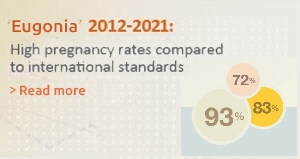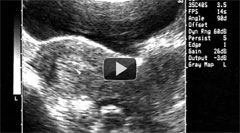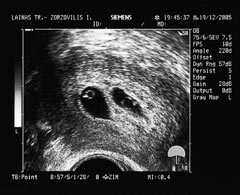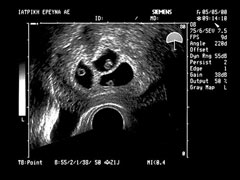Η Ευγονία διαθέτει ένα επιτυχημένο και εξειδικευμένο πρόγραμμα δωρεάς ωαρίων, βασισμένο σε αυστηρά πρότυπα ηθικής και δεοντολογίας. Το πρόγραμμα μας εστιάζεται στην ασθενή, αποφεύγοντας το προφίλ προγραμμάτων δωρεάς μαζικής κλίμακας. Αυτό αντανακλάται και στα κορυφαία ποσοστά επιτυχίας της Μονάδας.
Ποιές γυναίκες χρειάζονται δωρεά ωαρίων
Αξιολόγηση και εξετάσεις της δότριας
Νομοθεσία
Διαδικασία δωρεάς
Ποιες γυναίκες χρειάζονται δωρεά ωαρίων
Είναι γνωστό ότι ορισμένες γυναίκες δεν έχουν την δυνατότητα να παραγάγουν δικά τους ωάρια. Οι γυναίκες αυτές δεν έχουν άλλον τρόπο για να τεκνοποιήσουν, παρά μόνον την δωρεά ωαρίου. Αυτό σημαίνει ότι πρέπει να υποβληθούν σε εξωσωματική γονιμοποίηση, κατά την οποία θα χρησιμοποιηθεί το σπέρμα του συζύγου τους, με ωάρια κάποιας άλλης γυναίκας. Η δωρεά ωαρίων αφορά την διάθεση όλων των ληφθέντων ωαρίων από ανώνυμη δότρια για χρήση από μία ή περισσότερες ανώνυμες λήπτριες.
Στην κατηγορία αυτή βρίσκονται:
- γυναίκες οι οποίες για κάποιο λόγο έχουν χάσει τις ωοθήκες τους,
- γυναίκες που έχουν υποστεί ακτινοθεραπεία ή χημειοθεραπεία,
- νεαρές γυναίκες σε πρόωρη εμμηνόπαυση,
- γυναίκες των οποίων οι ωοθήκες δεν ανταποκρίνονται ούτε σε ιδιαίτερα υψηλές δόσεις διεγερτικών φαρμάκων.
Αξιολόγηση και εξετάσεις της δωρήτριας
Πραγματοποιούμε ενδελεχή αξιολόγηση όλων των υποψήφιων δωρητριών, και μόνο αυτές που είναι ιατρικά και ψυχολογικά υγιείς γίνονται δεκτές στο πρόγραμμα. Επίσης, καταβάλλουμε κάθε προσπάθεια να αντιστοιχίσουμε τα χαρακτηριστικά της δωρήτριας με τα δικά σας στο μεγαλύτερο δυνατό βαθμό.
Συγκεκριμένα, στην Ευγονία οι δωρήτριες αξιολογούνται με βάση το προσωπικό και το ιατρικό τους ιστορικό από ομάδα ειδικών.
- Στην πρώτη συνάντηση γίνεται λεπτομερής λήψη ιστορικού από την υπεύθυνη του προγράμματος δωρεών.
- Κατά τον βασικό έλεγχο από τον υπεύθυνο γιατρό αναπαραγωγής σημαντική προϋπόθεση είναι η εκτίμηση των ωοθηκικών εφεδρειών αλλά και τα επίπεδα των ορμονών.
- Στη συνέχεια, σε συνεργασία με τον γενετιστή εξετάζεται με λεπτομέρεια το οικογενειακό ιστορικό κληρονομικών διαταραχών και συστήνονται εξειδικευμένες εξετάσεις όπως για παράδειγμα:
Κυστική ίνωση (έως 99% των μεταλλάξεων του γονιδίου CFTR), ευαίσθητο Χ χρωμόσωμα, α,β και δβ -θαλασσαιμία, νωτιαία μυική ατροφία (εξώνια 7 και 8), μη συνδρομική βαρηκοΐα (μεταλλάξεις 35delG and L90p), καρυότυπος.
- Επίσης οι δωρήτριες ωαρίων υποβάλλονται σε περαιτέρω έλεγχο,( εξετάσεις για σεξουαλικώς μεταδιδόμενα νοσήματα, προγεννητικό έλεγχο, μοριακοί έλεγχοι για ηπατίτιδες και HIV ) υπερβαίνοντας κατά πολύ τις υποχρεωτικές από το νόμο εξετάσεις.
- Οι δωρήτριες ωαρίων, καθώς και οι αποδέκτες, έχουν τη δυνατότητα για ραντεβού με εξειδικευμένο ψυχολόγο της Μονάδας, εάν το επιθυμούν.
Τέλος, σημαντική παράμετρος στα προγράμματα δωρεών είναι η πλήρης ενημέρωση των υποψήφιων σχετικά με την διαδικασία της εξωσωματικής γονιμοποίησης, τους πιθανούς κινδύνους και την νομοθεσία.
Νομοθεσία
- Ανωνυμία: Σύμφωνα με το ισχύον ελληνικό νομικό πλαίσιο είναι υποχρεωτική η διαφύλαξη της ανωνυμίας των δοτών και των ληπτών γαμετών και εμβρύων. Επίσης, τηρείται ένα απόρρητο αρχείο των δωρεών, το οποίο δεν κοινοποιείται ούτε στους δότες, ούτε στους λήπτες, αλλά μπορεί να χρησιμεύσει μελλοντικά, εάν και εφ’όσον κάτι τέτοιο απαιτηθεί διά νόμου. Η ανωνυμία και εν γένει το ιατρικό απόρρητο των δωρεών διαφυλάσσεται απολύτως: εάν έχετε αποδεχθεί την δωρεά ωαρίων ή εμβρύων, δεν θα σας ενημερώσουμε με κανένα τρόπο για την έκβαση της προσπάθειας των ληπτών. Αντιστοίχως, οι λήπτες δεν θα μάθουν κανένα στοιχείο σχετικό με την ταυτότητά σας ή τον ιατρικό σας φάκελο, πλην των πληροφοριών που σχετίζονται άμεσα με την υγεία τους (π.χ. ομάδες αίματος-Rhesus, “στίγμα” Μεσογειακής αναιμίας κ.λπ.).
- Όρια ηλικίας: Η δότρια ωαρίων πρέπει να είναι 18-35 ετών. Η επιτρεπόμενη ηλικία για υποβολή σε εξωσωματική γονιμοποίηση για όλες τις γυναίκες είναι πριν τη συμπλήρωση του πεντηκοστού έτους.
- Συγκατάθεση των δοτών και των ληπτών: Η πολιτική μας στον τομέα αυτόν είναι απόλυτη. Θεωρούμε αδιανόητη την δωρεά ωαρίων ή εμβρύων χωρίς την λεπτομερή ενημέρωση και την έγγραφη συγκατάθεση των τεσσάρων εμπλεκομένων: οι δότες καλούνται να υπογράψουν ειδικά έντυπα, με τα οποία εξουσιοδοτούν την θεραπευτική ομάδα να προχωρήσει στην δωρεά οι λήπτες υπογράφουν αντίστοιχα έντυπα, με τα οποία δηλώνουν ότι αποδέχονται την δωρεά. Τα έντυπα αυτά τηρούνται στο απόρρητο αρχείο.
- Αριθμός μεταφερομένων εμβρύων: Επιτρέπεται η μεταφορά έως 2 εμβρύων, όταν αυτά προέρχονται από δανεικά ωάρια.
- Διάρκεια κρυοσυντήρησης: Τα κατεψυγμένα έμβρυα μπορούν να διατηρηθούν για χρονικό διάστημα 5 ετών. Η διάρκεια της κρυοσυντήρησης μπορεί να παρατείνεται για πέντε (5) έτη κάθε φορά με έγγραφη αίτηση των δικαιούμενων και ανώτατο όριο παράτασης τα είκοσι (20) έτη (Ν. 4737/2020 (ΦΕΚ Α’ 204/22-10-2020).
Διαδικασία δωρεάς – Λήπτες
1. Αξιολόγηση, ενημέρωση και συμβουλευτική
Στην 1η συνάντηση που θα έχετε μαζί μας, θα συμπληρώσουμε ένα λεπτομερές ιστορικό. Στη συνέχεια θα συζητήσετε με τον Διευθυντή της μονάδας για την προοπτική της δωρεάς, την κατάλληλη θεραπευτική προσέγγιση και το πρωτόκολλο φαρμακευτικής προετοιμασίας αφού γίνει πλήρης κλινική αξιολόγηση.
θα ενημερωθείτε πλήρως για το νομοθετικό πλαίσιο, την προετοιμασία και τις εξετάσεις της δωρήτριας, θα πάρετε πληροφορίες και οδηγίες για την δική σας αγωγή αλλά και συνολικά για την διαδικασία από την υπεύθυνη του προγράμματος δωρεών.
2. Κύκλος προετοιμασίας
Για να μεγιστοποιήσουμε την πιθανότητα επιτυχίας θα υποβληθείτε σε συγκεκριμένες εξετάσεις που θα σας προτείνουμε ανάλογα με το ιστορικό σας.
Αυτές μπορεί να περιλαμβάνουν υστεροσκόπηση, προγεννητικό έλεγχο, εξετάσεις του συζύγου.
Επιπλέον, αν το επιθυμείτε μπορείτε να ζητήσετε ραντεβού με την ψυχολόγο μας. Στόχος μας είναι να βοηθήσουμε το ζευγάρι να εξετάσει και να λάβει υπόψη του όλες τις πιθανές επιπτώσεις που μπορεί να έχει η προτεινόμενη θεραπεία, στους ίδιους, στην οικογένειά και στο παιδί που θα γεννηθεί ως αποτέλεσμα της θεραπείας αυτής.
3. Κύκλος θεραπείας
Είναι σημαντικό για την λήπτρια να έχει προετοιμαστεί με την κατάλληλη θεραπεία ώστε να συγχρονιστεί το ενδομήτριο της με τα γονιμοποιημένα ωάρια. Ο κύκλος θεραπείας για τον συγχρονισμό της προσπάθειας δημιουργεί το κατάλληλο περιβάλλον για την υποδοχή των εμβρύων. Ο κύκλος με ορμονική θεραπεία υποκατάστασης αποτελεί ιδανική λύση . Οι θεραπείες ξεκινούν βάσει περιόδου και περιλαμβάνουν χάπια και ενέσεις.
4. Το εργαστηριακό στάδιο
Το εργαστηριακό στάδιο αφορά τη γονιμοποίηση των ωαρίων με το σπέρμα του συντρόφου και την καλλιέργεια των εμβρύων στο εργαστήριο για 2-5 ημέρες.
Η όλη διαδικασία ολοκληρώνεται με τη μεταφορά των εμβρύων στην κοιλότητα της μήτρας της λήπτριας. Υπεράριθμα έμβρυα καταψύχονται και φυλάσσονται στην Τράπεζα Κρυοσυντήρησης της Ευγονίας για μελλοντική χρήση.
Εάν ενδιαφέρεστε να γίνετε δότρια ωαρίων και είστε κάτω των 35 ετών (απαραίτητη προϋπόθεση σύμφωνα με την νομοθεσία), μπορείτε να επικοινωνήσετε μαζί μας.























































 Surrogacy applies to couples with normal eggs and sperm but the woman has a non functional uterus or is unfit to gestate for medical reasons.
Surrogacy applies to couples with normal eggs and sperm but the woman has a non functional uterus or is unfit to gestate for medical reasons.









































